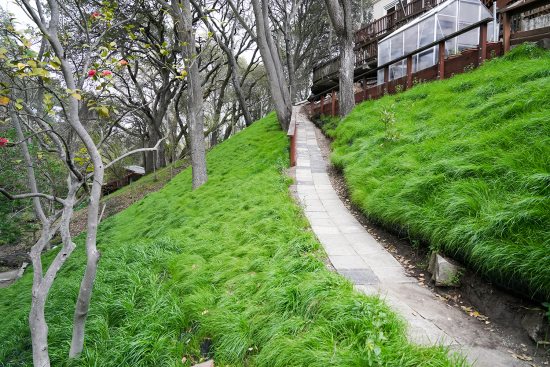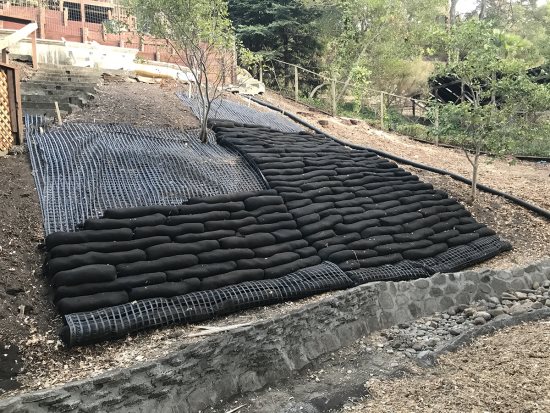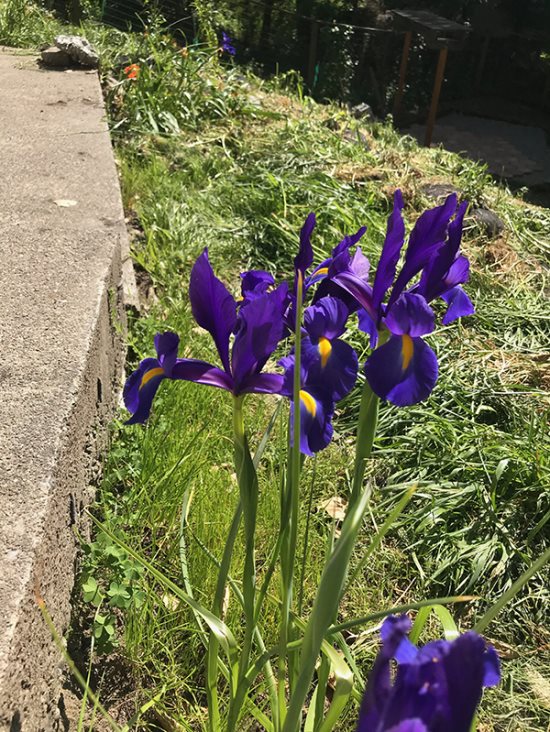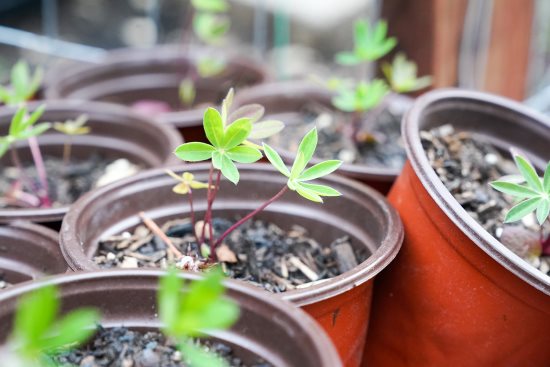 | | | A living retaining wall sprouts green on the hillside. Photo Gint Federas | | | | | | After 33 years living in Lafayette in the same house, Gint Federas and his wife, Geni, took on a major landscaping project to halt the erosion of their property. "We originally had a retaining wall which directed the water, but it led to extensive erosion of the land below," Federas said. "We had a lot of ivy which we removed at the direction of the fire marshal which exposed how serious the erosion problem was."
 This was no small project on a property that measures two-thirds of an acre. Federas, who grew up in an urban environment and now considers himself a "gentleman farmer," weighed his options as to the best way to stabilize the hill. "I considered building retaining walls with wood or blocks, but I felt it was unsightly and extremely expensive," Federas said. "So, I did a lot of research on retaining walls and I found someone who was doing creek and river remediation with the heavy-duty polypropylene tubular mesh netting (Grosoxx)." The Grosoxx is designed to stabilize banks and prevent erosion on waterways and shoreline banks. Besides the ecological benefit of using the Grosoxx, when costed out, it was about 80% cheaper than putting in retaining walls.
This was no small project on a property that measures two-thirds of an acre. Federas, who grew up in an urban environment and now considers himself a "gentleman farmer," weighed his options as to the best way to stabilize the hill. "I considered building retaining walls with wood or blocks, but I felt it was unsightly and extremely expensive," Federas said. "So, I did a lot of research on retaining walls and I found someone who was doing creek and river remediation with the heavy-duty polypropylene tubular mesh netting (Grosoxx)." The Grosoxx is designed to stabilize banks and prevent erosion on waterways and shoreline banks. Besides the ecological benefit of using the Grosoxx, when costed out, it was about 80% cheaper than putting in retaining walls.
 The first thing Federas did was to remove the non-native trees. "We cut out all of the pine, palm and other non-native trees. Our plan was to make a "permaculture" where native plants, bushes and trees would not need added water or chemicals to be able to grow anything."
The first thing Federas did was to remove the non-native trees. "We cut out all of the pine, palm and other non-native trees. Our plan was to make a "permaculture" where native plants, bushes and trees would not need added water or chemicals to be able to grow anything."
 Federas purchased 16,000 feet (over 3 miles) of the Grosoxx, cutting it into two-to-three-foot lengths, tying off one end and filling it with seed and compost. After mixing 300 pounds of seed and 300 tons of compost, it took Federas and three assistants three months to fill up enough Grosoxx to fill in one half of the hill. Fortunately for Federas, "I discovered a Min-FX machine which is custom made by Filtrexx. It filled up the Grosoxx like a sausage machine, far faster than we could manually." In the end, it only took three weeks to prepare the Grosoxx for the other half of the hill.
Federas purchased 16,000 feet (over 3 miles) of the Grosoxx, cutting it into two-to-three-foot lengths, tying off one end and filling it with seed and compost. After mixing 300 pounds of seed and 300 tons of compost, it took Federas and three assistants three months to fill up enough Grosoxx to fill in one half of the hill. Fortunately for Federas, "I discovered a Min-FX machine which is custom made by Filtrexx. It filled up the Grosoxx like a sausage machine, far faster than we could manually." In the end, it only took three weeks to prepare the Grosoxx for the other half of the hill.
 Federas and his crew started at the bottom of the hill and laid each of the Grosoxx side-by-side and row-by-row up the hill. "We held the Grosoxx in place using geogrid fabric (geosynthetic material used to reinforce soils), particularly in the steeper area," Federas said. "This would keep the Grosoxx from rolling down the hill and was particularly effective on areas that were steepest. We flattened the Grosoxx to key them into the hillside and would lay another layer on them, going up the hill continuously. It's called Mechanically Stabilized Earth (MSE)," he said. "In soil engineering terms, the goal is to contain, reinforce, and vegetate. Cosmetically, the `living retaining wall' adds tens of thousands of flowers and attracts natural pollinators like bees, butterflies and hummingbirds."
Federas and his crew started at the bottom of the hill and laid each of the Grosoxx side-by-side and row-by-row up the hill. "We held the Grosoxx in place using geogrid fabric (geosynthetic material used to reinforce soils), particularly in the steeper area," Federas said. "This would keep the Grosoxx from rolling down the hill and was particularly effective on areas that were steepest. We flattened the Grosoxx to key them into the hillside and would lay another layer on them, going up the hill continuously. It's called Mechanically Stabilized Earth (MSE)," he said. "In soil engineering terms, the goal is to contain, reinforce, and vegetate. Cosmetically, the `living retaining wall' adds tens of thousands of flowers and attracts natural pollinators like bees, butterflies and hummingbirds."
 Once the grass seed roots, it ties the Grosoxx bags together to form a "living retaining wall" of tubes interlocked above, below and between with root fibers. Deep-rooted, native flowers will replace grass after they start from seed. With over 10,000 planned plantings, buying flats from nurseries would be cost prohibitive.
Once the grass seed roots, it ties the Grosoxx bags together to form a "living retaining wall" of tubes interlocked above, below and between with root fibers. Deep-rooted, native flowers will replace grass after they start from seed. With over 10,000 planned plantings, buying flats from nurseries would be cost prohibitive.
 "We're ramping up about 1,000 seed plantings each weekend," said Federas. "All plantings will be deep-rooted and native. Once they get established, their roots will grow deeper through the bag and root several feet into the ground."
"We're ramping up about 1,000 seed plantings each weekend," said Federas. "All plantings will be deep-rooted and native. Once they get established, their roots will grow deeper through the bag and root several feet into the ground."
 The Federases will be planting numerous flowers for year-round and ever-changing colors. "They are all going to be native, deep rooted flowers like black eyed Susans, echinacea, salvia, lupine, milkweed and African daisies," Federas said. "It's important to have them be deep rooted natives because once they deep root, you don't have to water or fertilize them anymore and they are low maintenance. They'll seek their own water in the hillside. The tubes shade the dirt below and reduce evaporation, like adding six inches of mulch on top of the soil. Plus, these flowers will attract bees and butterflies and aren't liked by deer. They will bloom from early spring through late fall. On the shady side, we're planting Coleus and hosta."
The Federases will be planting numerous flowers for year-round and ever-changing colors. "They are all going to be native, deep rooted flowers like black eyed Susans, echinacea, salvia, lupine, milkweed and African daisies," Federas said. "It's important to have them be deep rooted natives because once they deep root, you don't have to water or fertilize them anymore and they are low maintenance. They'll seek their own water in the hillside. The tubes shade the dirt below and reduce evaporation, like adding six inches of mulch on top of the soil. Plus, these flowers will attract bees and butterflies and aren't liked by deer. They will bloom from early spring through late fall. On the shady side, we're planting Coleus and hosta."
 How many flowers overall will be planted on the property? Thousands and thousands, and then some.
How many flowers overall will be planted on the property? Thousands and thousands, and then some.
 It was on Greenhorizonsenvironmental.com where Federas originally learned about Grosoxx which was invented by Rod Taylor. What must be most satisfying for Federas and his wife is that same website which lists the successful projects using their Grosoxx, the Federas Residence is prominently listed as a case study to emulate.
It was on Greenhorizonsenvironmental.com where Federas originally learned about Grosoxx which was invented by Rod Taylor. What must be most satisfying for Federas and his wife is that same website which lists the successful projects using their Grosoxx, the Federas Residence is prominently listed as a case study to emulate.
 Federas has been sharing his work on Facebook and welcomes any questions that anyone might have if they are faced with a similar project.
Federas has been sharing his work on Facebook and welcomes any questions that anyone might have if they are faced with a similar project.
 Federas' next project? "Sleep."
Federas' next project? "Sleep." |



